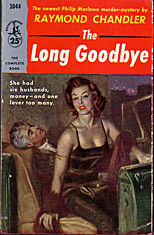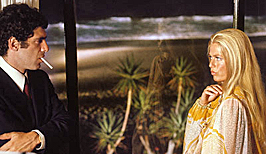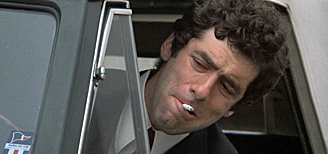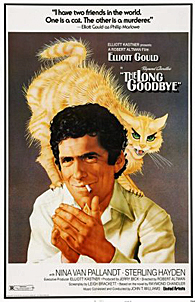Tue 20 Dec 2016
A Book! Movie!! Review by Dan Stumpf: RAYMOND CHANDLER – The Long Goodbye / Film (1973).
Posted by Steve under Mystery movies , Reviews[12] Comments

RAYMOND CHANDLER – The Long Goodbye. Houghton Mifflin, hardcover, 1954. Reprinted many times in both hardcover and soft, including Pocket 1044, 1955.
THE LONG GOODBYE. United Artists, 1973. Elliott Gould, Nina van Pallandt, Sterling Hayden, Mark Rydell, Henry Gibson, David Arkin, Jim Bouton. Screenplay by Leigh Brackett, based on the novel by Raymond Chandler. Director: Robert Altman.
I discovered Raymond Chandler back in High School, re-read him after College, and still dip into his work now and again. But I’ve kind of resisted re-visiting The Long Goodbye, which I recalled as somewhat flabby and overrated. Well, I approached it again a few years ago with interest and a bit of trepidation, wondering if I’d finish it. Then in the first couple pages I came across the line “She gave him a look that should have stuck out his back four inches,” and my ticket was stamped for the ride.

I wouldn’t call Goodbye flabby; it is/was over-rated by critics impressed by Chandler’s carping John-D-MacDonald-style about the society we live in, the sorry state of television and gays in the art world — all much less impressive fifty-odd years later. Goodbye lacks the vigor of The Big Sleep, and it’s not as poignant as The High Window, but Chandler keeps it moving with his own often-imitated prose and lively characters like Big Willie Magoon and Mendy Menendez, a flamboyant gangster who gives the piece a sense of motion even when there’s not much going on. I have to say, though, Goodbye really needs these colorful touches, because this plot re-e-ally takes its time unspooling. In all, I’m glad I took another look at it, but it’s far from his best.
In 1973 Robert Altman and Leigh Brackett (who co-adapted The Big Sleep for the movies in ’45) made a movie of The Long Goodbye which was generally scorned by critics, savaged by Chandler fans and ignored by the public — I’ve always loved it.

In those days before noir came back in style, it was artistically impossible to do a hard-boiled mystery like they used to – look at the sorry attempts with James Garner and Robert Mitchum – so Altman/Brackett turned “Raymond Chandler’s savagely disenchanted outlaw-within-the-law†(Bosley Crowther) or the “Knight Without Meaning†(Charles Gregory) into a faintly comic, out-of-step icon.

The sensitivity is still there, along with the Instant Bullshit Detector, but the showy hardness is replaced by bemused detachment and Popeye-mutter. It works, enacted by Elliott Gould and a superb cast including Nina Van Pallandt, Sterling Hayden, director Mark Rydell (great in the flashy-gangster role) Henry Gibson(!) and Arnold Schwarzenegger(try to spot him.)
I’m not a big fan of the late Robert Altman, but (as yet another critic pointed out) this movie shares a lot of qualities with Alphaville and Point Blank: dis-location of space and time, use of décor as landscape and landscape as décor, absurd violence, and stock characters who refuse to act like stereotypes… in all a film kinky, off-beat and surprisingly faithful.

As an interesting sidelight, Long Goodbye was done for television in 1954, or thereabouts with Dick Powell as Marlowe on an hour-long show called Climax – the same show that first did Casino Royale.
And another interesting bit: When this film came out I was dating two women, and dating them pretty seriously — seriously enough that I couldn’t afford to keep it up very long, so I took them to The Long Goodbye (on different nights; this was the 70s, not the 90s) to see how they reacted: One loved it, the other asked me how I could possibly enjoy such a film, and told me never to take her to another like it.
In due course, I married the second one.
